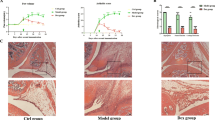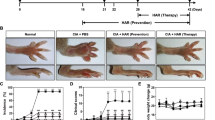Abstract
Background
Dexamethasone (DEX) is an effective therapeutic option commonly used in the treatment of many inflammatory diseases. However, DEX could impair proliferation or differentiation of osteoblasts, suggesting a pivotal role of DEX in bone destruction.
Objective
To investigate whether intraarticular injection of DEX could exacerbate bone erosion during CIA development.
Setting
Collagen-induced arthritis (CIA) mice were divided into PBS-treated and DEX-treated groups (n = 5/group). Negative control group: DBA/1 mice (n = 5) were used as age-matched, healthy, untreated controls.
Method
CIA was induced in male DBA/1 mice. Intraarticular injected DEX (0.01 mg/Kg, 10 μl) into the knee joint of CIA on Day 28, Day 35, Day 42 and Day 49 post the 1st immunization.
Results
The severity of the arthritic disease was ameliorated in DEX-treated mice, accompanied by the decreased expression of IL-6, IL-8 and TNF-α. However, DEX treatment accelerates bone erosion and osteoporosis during CIA development and triggers higher expression of RANKL, IL-17 in vitro and vivo.
Main outcome measure
The effect of DEX on bone structure was analyzed using Haematoxylin & Eosin (H&E) staining and Micro-CT. The levels of receptor activator for nuclear factor-κ B ligand (RANKL) and osteoprotegerin (OPG) were investigated by real-time PCR, Western Blot and immunohistochemical analysis. RASFs were stimulated with Interleukin (IL)-1β and then treated with different concentrations of DEX for 72 h.
Conclusion
Intraarticular injection of DEX could exacerbate bone erosion in CIA model via up-regulation of RANKL expression.




Similar content being viewed by others
References
Briot K, Cortet B, Roux C, Fardet L, Abitbol V, Bacchetta J et al (2014) 2014 update of recommendations on the prevention and treatment of glucocorticoid-induced osteoporosis. Jt Bone Spine 81(6):493–501
De A, Blotta HM, Mamoni RL, Louzada P, Bertolo MB, Foss NT et al (2002) Effects of dexamethasone on lymphocyte proliferation and cytokine production in rheumatoid arthritis. J Rheumatol 29(1):46–51
Du J, Cheng B, Zhu X, Ling C (2011) Ginsenoside Rg1, a novel glucocorticoid receptor agonist of plant origin, maintains glucocorticoid efficacy with reduced side effects. J Immunol 187(2):942–950
Hofbauer LC, Zeitz U, Schoppet M, Skalicky M, Schüler C, Stolina M et al (2009) Prevention of glucocorticoid-induced bone loss in mice by inhibition of RANKL. Arthritis Rheum 60(5):1427–1437
Kato T, Khanh VC, Sato K, Kimura K, Yamashita T, Sugaya H et al (2018) Elevated expression of Dkk-1 by glucocorticoid treatment impairs bone regenerative capacity of adipose tissue-derived mesenchymal stem cells. Stem Cells Dev 27:85–99
Kavanaugh A, Wells AF (2014) Benefits and risks of low-dose glucocorticoid treatment in the patient with rheumatoid arthritis. Rheumatology (Oxford) 53(10):1742–1751
Komori T (2016) Glucocorticoid Signaling and Bone Biology. Horm Metab Res 48(11):755–763
Lee YK, Kim SW, Park JY, Kang WC, Kang YJ, Khang D (2017) Suppression of human arthritis synovial fibroblasts inflammation using dexamethasone-carbon nanotubes via increasing caveolin-dependent endocytosis and recovering mitochondrial membrane potential. Int J Nanomedicine 12:5761–5779
Lems WF (2014) Are glucocorticoids harmful to bone in early rheumatoid arthritis? Ann N Y Acad Sci 1318:50–54
Morand EF (2007) Effects of glucocorticoids on inflammation and arthritis. Curr Opin Rheumatol 19(3):302–307
Piemontese M, Xiong J, Fujiwara Y, Thostenson JD, O’Brien CA (2016) Cortical bone loss caused by glucocorticoid excess requires RANKL production by osteocytes and is associated with reduced OPG expression in mice. Am J Physiol Endocrinol Metab 311(3):E587–E593
Sato AY, Tu X, McAndrews KA, Plotkin LI, Bellido T (2015) Prevention of glucocorticoid induced-apoptosis of osteoblasts and osteocytes by protecting against endoplasmic reticulum (ER) stress in vitro and in vivo in female mice. Bone 73:60–68
Schett G, Gravallese E (2012) Bone erosion in rheumatoid arthritis: mechanisms, diagnosis and treatment. Nat Rev Rheumatol 8(11):656–664
Shindo M, Ishii H, Kitano T, Miyazawa H, Ito K, Ueda Y et al (2016) Remitting seronegative symmetrical synovitis with pitting oedema (RS3PE) syndrome in a chronic kidney disease patient undergoing haemodialysis. Nephrology 21(12):1073
Smolen JS, Aletaha D, McInnes IB (2016) Rheumatoid arthritis. Lancet 388(10055):2023–2038
Solomon DH, Finkelstein JS, Shadick N, LeBoff MS, Winalski CS, Stedman M et al (2009) The relationship between focal erosions and generalized osteoporosis in postmenopausal women with rheumatoid arthritis. Arthritis Rheum 60(6):1624–1631
Straub RH, Cutolo M (2016) Glucocorticoids and chronic inflammation. Rheumatology (Oxford) 55(2):6–14
Tanaka S (2013) Regulation of bone destruction in rheumatoid arthritis through RANKL-RANK pathways. World J Orthop 4(1):1–6
Tolba MF, El-Serafi AT, Omar HA (2017) Caffeic acid phenethyl ester protects against glucocorticoid-induced osteoporosis in vivo: impact on oxidative stress and RANKL/OPG signals. Toxicol Appl Pharmacol 324:26–35
Walsh MC, Choi Y (2014) Biology of the RANKL-RANK-OPG system in immunity, bone, and beyond. Front Immunol 5:511
Weitoft T, Rönnelid J, Knight A, Lysholm J, Saxne T, Larsson A (2014) Outcome predictors of intra-articular glucocorticoid treatment for knee synovitis in patients with rheumatoid arthritis—a prospective cohort study. Arthritis Res Ther 16(3):R129
Funding
This study was supported by National Natural Science Foundation of China (NSFC) (81671615 and 81701610) and a project Funded by the Priority Academic Program Development of Jiangsu Higher Education Institutions (PAPD) and Young Medical People Project in Jiangsu Province.
Author information
Authors and Affiliations
Corresponding author
Ethics declarations
Conflict of interest
The authors declare that they have no competing interests.
Rights and permissions
About this article
Cite this article
Sun, X., Wang, Y., Zhang, M. et al. Intraarticular injection of dexamethasone promotes bone erosion in collagen-induced arthritis in mice through up-regulation of RANKL expression. Inflammopharmacol 27, 503–509 (2019). https://doi.org/10.1007/s10787-018-0541-6
Received:
Accepted:
Published:
Issue Date:
DOI: https://doi.org/10.1007/s10787-018-0541-6




